Parachute Regiment and Airborne Forces Museum
Coordinates: 51°15′40″N 0°45′47″W / 51.261°N 0.763°W
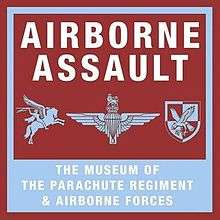 | |
| Established | 1946 |
|---|---|
| Location |
At Imperial War Museum Duxford since 2008 52°05′42″N 0°07′41″W / 52.095°N 0.128°W |
| Type | Regimental museum |
| Public transit access | Stagecoach C7 from Cambridge. |
| Website | http://www.paradata.org.uk/ |
The Parachute Regiment and Airborne Forces Museum is now located at Imperial War Museum Duxford. Prior to 2008 it was based at Browning Barracks in the Aldershot Military Town area near Aldershot in Hampshire. As well as the history of Airborne Forces in general, in particular the Museum told the story of the The Parachute Regiment, which was based in the town from its creation in 1940 until 2003.
Origins of the museum
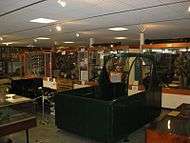
The Museum was established by a meeting of the Committee of the Parachute Regiment Association in October 1946, being housed in various barracks until it was officially opened in Browning Barracks on 23 March 1969 by Field Marshal Montgomery.
The Museum traced the history of British Airborne Forces from 1940 to the present day. With The Parachute Regiment having moved from its Aldershot home to Colchester in 2003, and with the site scheduled for redevelopment, a decision was made to move from 'behind the wire' to a public venue.
In 2008, the museum moved to a new permanent home in partnership with Imperial War Museum Duxford under the Airborne Assault name. The new attraction was opened in a formal ceremony by HRH The Prince of Wales, Colonel-in-Chief of The Parachute Regiment on 8 December 2008.
The exhibits
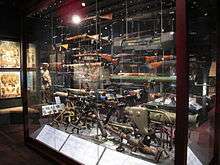
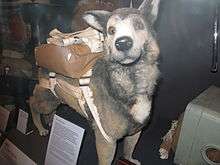
The new interactive Airborne Assault exhibition at IWM Duxford tells the story of men who go to war from the air.
New multimedia displays tell the story of today's airborne soldier and his heritage from 1940 when British Airborne Forces were first formed at the insistence of Prime Minister Winston Churchill. The displays include the original briefing models for airborne operations of World War II, including Bruneval, D-Day and the Rhine Crossing. The phases of the battle of Arnhem and Operation Market Garden are fully explained in a dedicated exhibit. Broad coverage is given to the post-war campaigns from Borneo and Suez to the Falklands War, Northern Ireland, and Afghanistan.
Exhibits of light weapons and heavy drop equipment from jeeps to field guns are suspended as if dropping into action. An original nosecone of the Horsaglider which carried airlanding troops into action at Normandy and the Rhine is featured, as well as Bing the Paradog, who dropped in 1945. There are displays of Parachute Regiment and Airborne Forces historical artefacts, including regimental colours, uniforms and medals which include several awards of the Victoria Cross and George Cross.
The museum also holds terminals to access the online archive ParaData. This is a contributory archive which aims to be the comprehensive database of all who have served in Airborne Forces, for the benefit of serving and retired soldiers, their families and descendants. ParaData also opened in December 2008 and can be found through the link below.
Medal Gallery
The Medal Gallery exhibits many of the medals awarded to British airborne troops, including the posthumous VCs awarded to Lt. John Hollington Grayburn of the 2nd Battalion the Parachute Regiment, Captain Lionel Ernest Queripel of the 10th Battalion the Parachute Regiment, and that awarded in 2007 to Corporal Bryan Budd, of the 3rd Battalion. In addition to those notable featured displays, the museum's entire collection is on display in specially designed secure drawers.
Making history
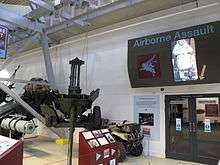

The vision for Airborne Assault is a unique attraction bringing alive the history and modern reality of The Parachute Regiment and Airborne Forces, from the Second World War to the Falklands, Kosovo, the Gulf and Afghanistan. Much of the 69-year history is captured on film and veterans from the D-Day landings and Arnhem are still alive and actively involved. The museum collection is now open to the public. Although Airborne Assault chronicles a proud history it is also about the present, and those who are currently out in the field "making history".
Central to this is ParaData - a comprehensive database record of all who have served, and are currently serving, linked to accounts and details of relevant campaigns and engagements. Photographs, documents, letters and film and audio interviews are appended to each entry where available, and contributions of further material are invited. The database aims to be a definitive history and a continually updated document for an estimated 500,000 descendants by 2016. Whilst paying respect to those who have served and their families, this will engage a younger audience, especially with reference to the National Curriculum, through the use of cutting-edge technology. Families will be able to research their history at touch screens and online.
References
A special booklet 'Airborne Assault: Stories of men who go to war from the air' edited by Robert J Kershaw was produced to commemorate the opening in 2008
External links
| Wikimedia Commons has media related to Parachute Regiment and Airborne Forces Museum. |
- Parachute Regiment and Airborne Forces Museum website
- ParaData the living history of The Parachute Regiment and Airborne Forces online
- List of Victoria Crosses held by the Museum
- The Museum on the Ogilby Trust's website